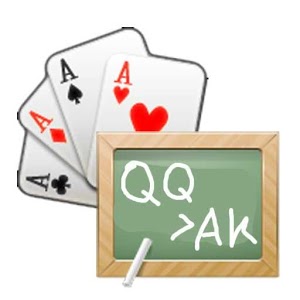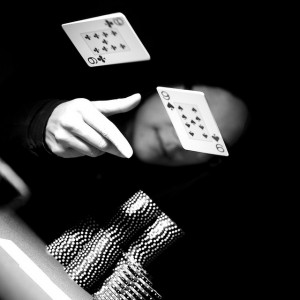The five biggest mistakes that average players make
Editor’s note: What follows is a special excerpt from Jeff Hwang’s upcoming book, tentatively titled Pot-Limit Omaha Poker: Advanced Play Vol. I.
When playing shorthanded pot-limit Omaha (PLO), the five biggest mistakes that the average player makes are:
1. Defending the blinds too liberally
2. Making big raises preflop from out of position
3. Not being aggressive enough
4. Overcompensating by being too aggressive with small-pot hands (such as undertrips, underfull, middle and bottom set, two pair, and so on)
5. Exercising poor game and seat selection
Blinds Defense
The first big mistake that average players make is defending their blinds too loosely. In contrast to shorthanded limit poker – which basically amounts to a fight over the blinds money – the blinds are relatively insignificant in PLO compared to what goes in the pot after the flop, even in shorthanded play. However, because the blinds come around faster in shorthanded play than in full-ring play, the average player tends to compensate by liberally defending his blinds against preflop raises.
The problem with defending your blinds is that you are just setting yourself up to play what will largely be defensive, small-pot poker from out of position. This is a situation with little upside, one that invites post-flop mistakes, and one that you can do without. In fact, particularly if you are just starting out in shorthanded PLO, you might even be better off not defending your blinds altogether!
Raising/Reraising Preflop From Out of Position
Another common error is making big raises from out of position.
When playing from out of position, your first priority is to keep the pot multiway. That said, you should avoid taking actions that will likely result in leaving you heads up after the flop and out of position. This means that you should tend to avoid making pot-sized raises from under the gun if the most likely result is that you pick up a caller behind you but both blinds fold; instead, you should tend to open-limp from under the gun, or otherwise keep your preflop raises small, to make it more inviting for the blinds to come in.
Likewise, if you are in the small blind, you should tend to avoid making pot-sized raises if doing so will knock out the big blind and leave you heads up with a limper. You should also tend to avoid three-betting from the small blind to knock out the big blind, for the same reason; this play might be standard in limit hold’em, and it might work in no-limit hold’em, but it is asking for trouble in PLO.
Yet, it is common for the small blind or the big blind to come out with a raise, because he thinks he is “attacking” the limper, when the game doesn’t actually work that way!
A lot of players do these things because they mistakenly believe that the preflop initiative is extremely valuable, when the reality is that positional advantage tends to trump preflop initiative in PLO. And for the most part, the only thing that raising from out of position accomplishes is to build a bigger pot while making the game more difficult to play.
Being Too Timid
One thing that is certainly true about shorthanded play is that you need to be aggressive if you want to win. This means capitalizing on opportunities to take down the pots that your opponents give up on. If you see a play, make it; failure to do so is a leak.
Aggressive players look for excuses to bet. You should, too.
Overcompensating
On the flip side, a lot of players overcompensate for shorthanded play by becoming more aggressive and raising with marginal holdings (such as undertrips, middle and bottom set, the bare nut straight, the underfull, and non-nut flushes), when actual hand strength dictates playing a small pot. This is another problem that is probably derived from the adjustments that players make when moving from full-ring to shorthanded limit hold’em, where you become more aggressive with thinner and thinner holdings. The difference is that in limit poker, the bets are relatively small compared to the size of the pot, whereas in PLO, you are often making full pot-sized bets.
In shorthanded play, the big-pot hands are still the big-pot hands, and the small-pot hands are still the small-pot hands. What’s different is that small-pot situations are the default in shorthanded play, largely because you will be contesting pots with far more marginal holdings, both before and after the flop.
Game Selection and Seat Selection
Probably the number-one mistake that PLO players make when playing shorthanded is exercising poor game and seat selection. While this is also true in full-ring play, the effects of poor game and seat selection are magnified in shorthanded play.
Let’s start with game selection. There is a tendency in some players to default to the biggest and toughest games they can find. However, in contrast to full-ring play, where pots tend to be contested multiway and the emphasis is on hand-valuation skills, the problem with playing shorthanded – where the emphasis is on greater poker skills – is that you will be involved in shorthanded confrontations with each of your opponents in basically every single hand. So, if you are going to play in a five-handed game with three world-class opponents, the fourth guy had better be awful.
Beyond table composition, another issue with regard to game selection is the nature of the game. A passive table where nobody ever raises preflop, for example, is generally more favorable than an aggressive one in which there is a raise preflop on every hand. The obvious benefit of a passive table is that you will get a free pass in the blinds more often. In contrast, in an aggressive game, there is a lot more pressure on your blinds, which might encourage you to make the mistake of defending them.
That said, if you are not comfortable giving up your blinds or otherwise playing in an aggressive game, just don’t sit in one!
The last issue is seat selection. Ideally, you’d like to have tight, passive players on your left, which will give you the freedom to play more liberally from the cutoff seat and perhaps the hijack position, and even under the gun, depending on how loose and/or passive the players are to your left. But what if you have a maniac directly on your left who raises preflop at every opportunity?
You want to know how to play with a maniac on your left, but the best answer is simply that you don’t. The maniac on your left may very well be the biggest loser at the table (it’s possible that he is a winner, too), but he is going to be disruptive to your game under any circumstances. The first thing you need to do is tighten up; but, ultimately, you need to either find another seat (preferably on the maniac’s left) or find another game.
This article was originally written by Jeff Hwang. Jeff Hwang is a semiprofessional player and author of Pot-Limit Omaha Poker: The Big Play Strategy. His latest book is Advanced Pot Limit Omaha Vol.1 and will be releasing Vol 2.
Submit your review | |













